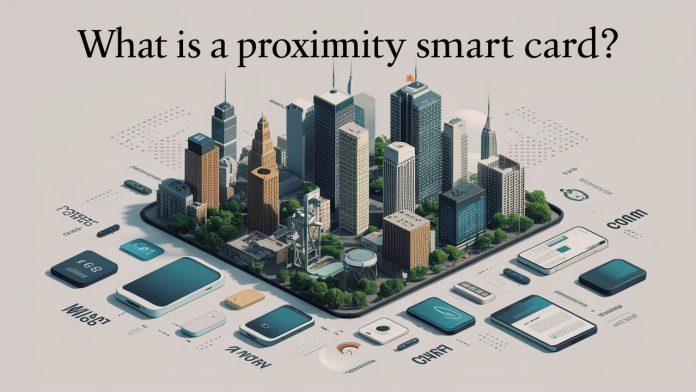Security and convenience go hand in hand. As technology advances, so do the methods we use to protect our assets and streamline our daily operations.
One of the most common methods of controlling access is through the use of proximity cards. However, as technology advances, a new type of card has emerged that combines the best features of proximity cards and smart cards – the proximity smart card.
Proximity Smart Cards: The Best of Both Worlds
Proximity smart cards combine the best features of proximity cards and smart cards. Like proximity cards, they use RFID technology to transmit data between the card and a reader. However, they also have a microchip embedded in them that can store multiple credentials and types of data, similar to smart cards. In older versions, you would see 125 kHz proximity cards, whereas newer contactless smartcards use 13.56 MHz.
This increased functionality makes proximity smart cards ideal for a wide range of applications. They can be used for access control, just like traditional proximity cards, but they can also be used for secure printing, cashless vending, and other applications that require additional layers of security and information.
Proximity smart cards are also more secure than traditional proximity cards. The data stored on the card is encrypted and cannot be easily duplicated, making it much harder for unauthorized individuals to gain access.
Read More Articles: Tips for Enhancing Durability and Strength of C25 Concrete Structures
Key Features of Proximity Smart Cards
Proximity smart cards have several key features that make them stand out from traditional proximity cards:
- Higher memory capacity: Proximity smart cards have a larger memory capacity than traditional proximity cards, allowing them to store multiple credentials and types of data.
- Increased functionality: The increased memory capacity of proximity smart cards allows them to be used for a wider range of applications, including access control, secure printing, cashless vending, and more.
- Enhanced security: The data stored on proximity smart cards is encrypted, making it much harder for unauthorized individuals to gain access. They also have an extra layer of security between the card reader and the card reader software.
- Compatibility: Proximity smart cards are compatible with both proximity card readers and smart card readers, making them a versatile choice for organizations that use a mix of card technologies.
Proximity Smart Cards vs. Traditional Proximity Cards
The table below summarizes all of the differences for you.
| Feature | Proximity Card | Proximity Smart Card |
| Memory Capacity | Lower | Higher |
| Uses and Functionality | Access control only | Access control, secure printing, cashless vending, and more |
| Security | Lower | Higher |
| Cost | Lower | Higher |
Types of Proximity Smart Cards
Standard Proximity Cards
A standard 125kHz proximity card is typically made from PVC and is the most common type used in access control systems. They are the same size as a CR80 ID card. These cards contain a simple microchip that transmits a unique identification number to the card reader when in proximity.
Composite Proximity Cards
Composite cards are made from a blend of PVC and polyester, providing enhanced durability compared to standard PVC cards. This makes them more resistant to wear and tear, especially in environments where cards are frequently used. They also withstand lamination and reverse transfer printing better.
Magnetic Stripe Proximity Cards
These cards combine the functionality of a proximity card with a magnetic stripe, allowing for additional data encoding. This feature is useful for organizations that require both access control and the ability to store transaction data, such as in cashless vending systems.
HID ISOProx Cards
ISOProx cards are designed for organizations that want to print directly on their proximity cards. Made from materials compatible with ID card printers, these cards allow for the addition of personalized information, such as employee names and photos, enhancing identification and security.
Proximity Card Key Fobs
Key fobs are compact proximity cards that can be attached to key rings. They provide the same functionality as standard proximity cards but in a smaller, more portable form. This is ideal for users who prefer not to carry a traditional card.
Read More Articles: The Technical Innovations of Sanson d’Abbeville in Cartography
HID iCLASS Cards
HID iCLASS cards are high-frequency smart cards that operate at 13.56 MHz. They provide enhanced security features, including encryption and the ability to store more data compared to traditional proximity cards. iCLASS cards can also be used in conjunction with HID proximity technology.
26 Bit Proximity Cards
26 bit proximity cards are a type of RFID card commonly used for access control. They operate at a frequency of 125 kHz and store a unique 26-bit facility code and card number that is transmitted to a compatible card reader when the card is placed nearby.
The 26-bit format, also known as the H10301 format, is the most widely used proximity card format. HID, a leading manufacturer of access control products, offers several 26-bit proximity card models, including:
- HID Prox Card 2 is a standard PVC proximity card available in 26-bit format
- HID 1326 Clamshell – A durable clamshell-style proximity card with a 26-bit format
- HID 1391 MicroProx Tag – A compact proximity tag with a 26-bit format, ideal for attaching to keychains or ID badges
Get Your Prox Cards Now
As you consider implementing or upgrading your access control system, reach out to Bristol ID Technologies. Get guidance in selecting the right technology and get yourself a robust access control system tailored to your specific needs.
Contact us today to learn more about how proximity smart cards can transform your security infrastructure and propel your organization into the future of access control.
